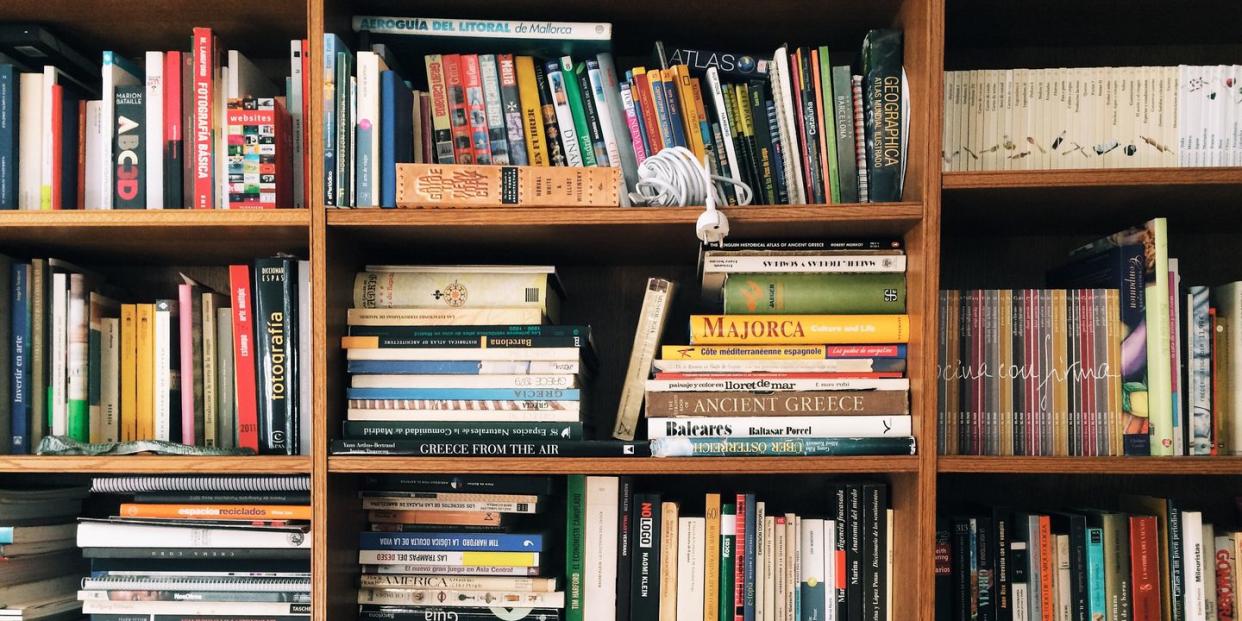Check Your Furniture ASAP: Mold Thrives on Particle Board and Pressed Wood

Without intending to, Marie Kondo opened my eyes to a serious mold problem in my home. You see, I'd been KonMari-ing my apartment, and just after placing a stack of Harry Potters in the "sparks joy" pile, I turned back to my bookcase to spot an unfortunate pattern of brown and white circles. Turns out, the porous material of my particle board shelves is perfect for mold to grab onto, and the glue the packs the wood chips together is still wet enough for the fungus to eat.
After some quick Googling, I soon learned it's an all-too-common issue, and that effectively killing mold on wood is a daunting task, to say the least. If you find yourself in a similar position, here's the best course of action, according to the US Forest Products Laboratory.
Stop the spread of mold
Items that have been sitting near the mold colony often are dusted with spores and growth. Bookcases, closets, and pantries are especially susceptible, since we're prone to "dust around" long-term items like earthquake kits, read books, and clothes you'll wear once you renew that gym membership. Before moving the infected items, clean them throughly so the mold doesn't move into a new home. Here's how:
Remove all the items on your furniture while wearing gloves, long sleeves and pants to minimize exposure. Open your windows and wear a face mask to avoid inhaling spores.
Using a diluted bleach mixture* (1/2 cup of bleach to 1 gallon of water, the US Occupational Safety and Health Administration recommends) wipe all mold from your objects. In my case, since this was my book collection, I carefully wiped the covers with Clorox wipes and immediately dried them so I wouldn't cause damage. For items that can't be wiped down or are too fragile, like interior book pages, place them outside in direct sunlight for an hour-the UV rays will kill the mold (just check the local forecast first).
*NOTE: Do NOT mix bleach with cleaning products that contain ammonia. It creates a toxic vapor.
Remove existing mold from wood
Once you've stopped mold from spreading onto other surfaces, like the new bookcase I bought at 10 p.m. in a panic, you'll need to kill the original source.
With gloves and protective clothing move the particle board outside if possible, a well ventilated area without carpet if not. Scrape or brush the pressed wood to remove as many of the mold spores as possible.
After clearing the particle board from all the fungus, use the same bleach mixture (1 cup of bleach to 1 gallon of water) to wash the pressed wood. If you used Clorox wipes like I did for your objects you'll have to switch to this stronger mixture for the source of the mold. Since bleach can cause discolor furniture test the mixture on the back of your piece to see how it will affect the veneer.
Set the piece to dry completely, in the sun if possible. Strong fans in a ventilated, isolated space like a garage can be a substitute during bad weather.
Replace damaged wood
Now that you've left the particle board to dry, check the pressed wood for any spores with gloves. If it's clear, you can bring the item back into the home and re-use. Still see a colony? The mold growth has burrowed too deep into the particle board and needs to be thrown away, according to Purdue University. You can still keep your furniture: Pressed wood is typically used as a backing or lining, so it can be easily removed with a hammer or flathead screwdriver.
Remove the particle board gently so as not to damage the rest of the piece and repeat the cleaning steps for any mold that may have hid under nails.
Replace particle board sheets with cut-to-measure pieces from any big box hardware store and throw out the damaged wood.
Prevent mold growth
Mold grows in humid, dark climates, so follow these tips from The Mother Nature Network to keep fungus out:
If you live in a warm climate, use the A/C to keep your home cool, never keep wet items sitting on surfaces, and pull your furniture away from the walls to keep everything ventilated.
Opt for chic pieces in plastic, metal and glass, as they are naturally resistant to mold. If you can't resist the call of a beautiful wooden piece, dust and disinfect regularly-especially after a storm. When painting or refinishing pieces, choose a product that's designed to prevent mold, like Zinsser's paint primer.
Follow House Beautiful on Instagram.
('You Might Also Like',)

